충치(우식증)와 불소, Dental caries and Fluoride 2/2/ 2022
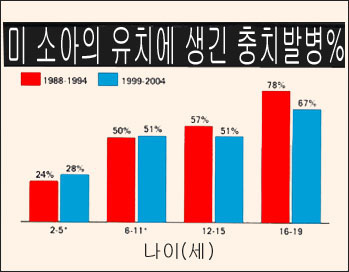
그림 3. 미국 아이들의 유치에 생긴 충치 발생률(%) 소스 : 미CDC
-
음식물 성분에 든 당질이 이의 맨 표면에 있는 법랑질층(에나멜)에 묻을 수 있다.
-
법랑질층에 묻은 당질이 부패될 때 당질에서 유기산이 생성된다.
-
이렇게 생성된 유기산 및, 또는 입속에 상존하는 박테리아 감염에 의해 법랑질층이 부식되어 생긴 치아 병을 충치라고 한다.
-
충치를 적절히 치료하지 않고 오랫동안 방치하면 충치가 법랑질층 바로 안쪽에 있는 상아질층까지 퍼져 상아질층도 부식될 수 있다.
-
상아질층이 부식된 충치를 적절히 치료하지 않고 오랫동안 방치하면 그 다음 치수까지 퍼져 치수가 부식되고, 결국에는 입안 점막층 즉 잇몸의 표면 위로 솟아 난 치아의 전체 치관이 다 부식될 수 있다.
-
그 정도의 충치가 점점 더 진행되면 맨 나중에는 이 뿌리(치근)만 남고 전 치아가 충치로 부식 된다.
-
이 정도까지 진행된 충치를 적절히 치료하지 않고 계속 더 방치되면 치수염, 치조돌기 골염, 치주조직염, 치간유두염 등 여러 종류의 합병증이 충치로 생길 수 있다.
충치(우식증)의 원인
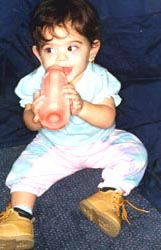
사진 4. 영유아들이 주스나 우유 등을 우유병에 담아 때를 가리지 않고 빨아 먹을 때 충치가 더 쉽게 생길 수 있다.
Copyright ⓒ 2011 John Sangwon Lee, M.D., FAAP
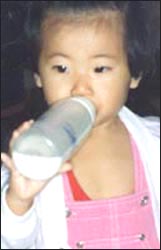
사진 5. 영유아들이 주스나 우유 등을 우유병에 담아 때 를 가리지 않고 빨아 먹을 때 충치가 생기기 쉽다.
Copyright ⓒ 2011 John Sangwon Lee, M.D., FAAP
-
충치가 생기는 기전은 이렇게 알려져 있지만 같은 조건을 가춘 아이들 중 어떤 아이들의 치아에는 충치가 더 쉽게 생기고 더 심하게 생기고 다른 아이들의 치아에는 충치가 덜 생기거나 통 생기지 않는 이유는 아직 확실히 모른다.
충치(우식증)가 더 잘 발생하게 하는 조건
① 임신 중 균형 잡힌 음식물을 충분히 섭취하지 못한 임산부로부터 태어난 아이들
② 건강 상태가 전반적으로 좋지 않은 아이들
③ 이를 적절히 닦지 않고 치사 치아 건강관리를 적절히 하지 않는 아이들
④ 당질이 든 음식물을 자주 많이 먹고 먹은 후 치아를 닦지 않는 아이들
⑤ 불소를 충분히 섭취하지 않는 아이들
⑥ 그 외 -유전 등
충치(우식증)의 증상 징후
-
충치의 정도와 합병증의 유무에 따라 증상 징후가 다르다.
-
경미한 충치가 있을 때는 법랑질층(enamel)만 조금 부식된 것 이외 별다른 증상 징후가 없는 것이 보통이다.
-
그러나 충치가 더 진행되면 충치에 구멍이 뚫릴 수 있고 더 심하면 치관 전체도 부식될 수 있다.
-
충치로 뚫린 치아 구멍 속으로 음식물 찌꺼기가 들어가면 치아가 아플 수 있다.
-
차거나 뜨건 음식물을 먹을 때 치아가 시리기도 하고 감각이 예민해질 수 있다.
-
충치로 법랑질층과 상아질층이 다 침식되어 그 두 층이 다 없어지면 충치구멍을 통해서 박테리아가 충치에 침입하여 치수염이 생길 수 있고 심한 치통이 생길 수 있다.
-
젖니(유치)에 생긴 충치를 적절히 치료해 주지 않고 오랫동안 방치하면 앞으로 날 영구치에 영향 줄 수 있다.
-
유치에 생긴 충치를 적절히 치료하지 않고 6~12개월 동안 그대로 놓아두면 충치로 생긴 이 뿌리(치근)가 계속 더 파괴될 수 있고 결국에는 그 충치의 치수조직까지 파괴될 수 있다.
-
이 때 찬 음식물을 먹을 때 이가 시릴 수 있고 음식물을 씹을 때 아플 수 있다.
-
그런 충치가 더 계속 진행되면 치수조직이 파괴되고 거기에 박테리아 감염이 생겨 박테리아성 치수염이 생길 수 있고 박테리아성 치수염이 악화되면 그 주위 치조 조직도 파괴될 수 있다.
-
이 때 치수염을 일으킨 박테리아가 얼굴과 안구 주위 조직까지 감염할 수 있다.
-
그로 인해서 안면 봉소염이나 안구 주위 봉소염이 생길 수 있다.
-
이런저런 이유로 젖니에 생긴 충치를 적절히 치료해야 한다 1.
-
심한 충치로 이가 많이 파괴됐을 때는 그로 인해 언어 발육 지장이 생길 수 있고, 소화장애 등 여러 가지 합병증이 생길 수 있다.
-
영구치가 삐뚤어져 나거나 치열이 고르지 않게 생키할 수 있다.
-
영구치가 이렇게 나면 미관상으로 좋지 않을 뿐 아니라 치주염의 원인이 될 수 있다.

사진 1-111. 심한 충치다
Copyright ⓒ 2012 John Sangwon Lee, MD., FAAP
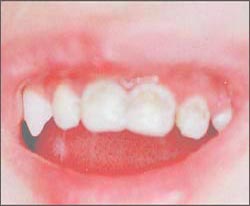
사진 25. 18개월 된 유아의 치아에 생긴 우유병 1도 충치
Copyright ⓒ 2011 John Sangwon Lee, M.D., FAAP
충치(우식증)의 진단
-
증상 징후, 진찰소견, 치아 X-선 사진검사 등으로 진단한다.
-
치과 의사는 충치의 초기에 충치를 쉽게 진단할 수 있지만 경미한 충치가 있을 때 겉으로 그냥보고 충치가 있는지 쉽게 알 수 없다.
-
소아청소년 특히 영유아들에게 충치가 생기는지 조심히 관찰해야 한다.
-
생후 2살 반~3살 될 때부터 유아들과 학령기 아이들은 정기적 치과 진료를 받고 충치가 있는지 검진 받고 치아와 구강에 어떤 이상이 있나 알아봐야 한다.
-
충치가 생기지 않게 미리부터 충치를 예방 해 주기 위해 충치를 잘 일으킬 수 있는 여러 가지 요인들이 무엇인지 알아야 한다.
충치 예방(우식증 예방)
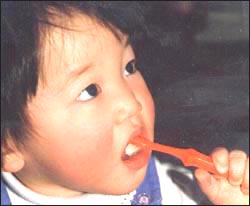
사진 13. 식사 후 칫솔질을 잘 한다.
Copyright ⓒ 2011 John Sangwon Lee, M.D., FAAP
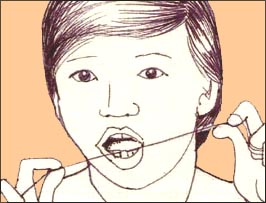
그림 14. 플러스(치사)로 치구가 생기지 않게 이 사이에 낀 음식물을 제거한다..
Copyright ⓒ 2011 John Sangwon Lee, M.D., FAAP
-
소아들에게 생기는 가장 흔한 만성 질환들 중 하나가 충치이다. 특히 빈곤층 소수게 어린이들에게 더 많이 충치기 생긴다.
-
건강한 좋은 치아를 갖기 위해서는 구강 건강을 잘 유지 해야 한다. 충치는 몬 전체 건강에 큰 영향을 줄 수 있다. 그뿐만 아니라 각 개안의 건강, 교육, 경제면에 부적정적으로 영향을 주고 사회생횔에도 크게 영향을 미칠 수 있다.
-
임신중 임산부의 건강 유지도 태어나는 아이의 치아 건강에 영향을 주지만 태어난 후 부모와 소아과 의료인들은 그 아이의 충치예방에 힘써야 한다.
-
특히 소아과 의사들은 신생아에서부타 사춘기 까지 소아 청소년들의 총체적인 건깅관리를 책임지고 잇기때문에 그들의 영양상태도직접 간접적으로 관리할 책임이 있기때문에 충치 예방과 치료에 관심을 기울여야 한다.
- 충치가 생기지 않게 미리부터 충치 예방을 하기 위해 충치를 잘 일으키는 여러 가지 요인들이 무엇인지 알아본다.
- 자녀가 건강한 치아를 가지고 일생동안 건강하게 살 수 있도록 임산부와 수유모는 불소가 든 균형 잡힌 음식물을 충분히 섭취해야 한다.
- 매일 먹는 음료수나 음식물에 권장 1일 필요 불소 양보다 더 적은 불소 양이 들어 있으면
- 의사의 처방에 따라 불소를 복용하든지, 나이에 다라 불소가 든 치약( Fluoride toothpaste)을 치아에 바르든지 치약으로 이 치소질을 하든지 rmcldordmf , 치아에 불소 바니쉬(Fluoride Varnish)를 바르든지, 불소가 든 물로 이를 가시어 충치 예방을 하든지, 또는 그 지방 공동 식수에 불소를 첨가해 충치를 예방한다. 일단 생긴 충치를 필요에 따라 실버 다아마인 불소(Silver Diamine Fluoride)으로 치요도 한다.
- 불소가 든 치약( Fluoride toothpaste)으로 생후 이가 나자 마자 쌀 크기만한 불소가 든 치약을바르든지 이런 치료를 생후 3세까지 한다. 뱉어 낼수 있으면 3세 부터 콩알 크기의 불소가 든 치약을 치아에다 바른다.
- 요즘은 소아과 의사들은 소아과 진료실에서 불소 바니쉬(Fluoride Varnish)를 첯 이가 나자 마자 건강상 고위험도 소아들에게는 매 3개월 마다, 건강상 위험도가 없는 소아들에게는 6개월 마다 이에 발라주기 시작 해서 생후 5세까지 발라서 소아 충치를 예방 하는 경향이 있다.
- 설탕, 과자, 껌, 콜라 등 당질 성분 음식물을 먹은 후 이를 바로 닦는다. 사탕 등 당질 성분이 든 음식물을 자주 먹는 것을 삼가 한다.
- 2~3살 유아기 때부터 성인기까지 매년 한두 번 정도 정기 치과검진을 받고 충치를 적절히 예방해 주고 치아에 어떤 문제가 생기면 그도 적절히 치료받는다.
- 하루 주식을 먹은 후 가능한 한 치아 를 닦는다. 특히 자기 전에 치아를 꼭 닦고 자도록 한다.
-
모유를 수유하는 아기나 인공영양을 먹는 아기는 생후 6개월 까지 특별히 불소를 따로 섭취 할 필요가 없다.
사진 17. 채소류와 과일류 음식물을 충분히 섭취한다.
Copyright ⓒ 2011 John Sangwon Lee, M.D., FAAP
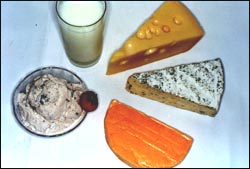
사진 18. 체질에 맞으면 우유나 우유로 만든 음식을 충분히 섭취한다.
Copyright ⓒ 2011 John Sangwon Lee, M.D., FAAP
다음은 “충치(우식증), 잇몸에서 피가 나요”에 관한 인터넷 소아청소년 건강상담 질의응답의 예 입니다. |
Q&A. 충치(우식증), 잇몸에서 피가 나요
Q.
돌을 지나고부터 우유병 우식증이 시작되어 서서히 진행되다가 이제는 앞니(웃니)4개 모두가 삭어들어가고 있습니다
치과에 가보니 두돌이 지난 후에 오라고 해 아직 치료를 시작하지 못한 상태입니다
그 이전까지 특별한 관리방법이 없는지 궁금해 글을 올립니다
답변 부탁드리겠습니다 고맙습니다
A.
형님께
안녕하세요. 질문해 주셔서 감사합니다. 좋은 질문입니다.
아이의 나이, 성별, 과거 병력, 가족 병력, 진찰소견, 임상검사 등의 정보를 많이 알수록 답변을 드리는데 도움이 됩니다. 주신 정보를 토대로 해서 답변을 드리겠습니다.
아기에게 충치(우식증)가 생긴 것 같습니다.
충치는 다음과 같은 원인으로 생길 수 있습니다.
임신 중 임신부가 섭취한 영양분, 출생 후 영양 상태, 불소 섭취 량, 우유병을 물려 재우는 습관, 당분이 든 과자나 사탕 등을 많이 자주 먹는 습관 등에 따라 충치가 더 쉽게 생길 수 있습니다.
특히 아무 때나 젖병을 빨거나 젖병을 물려 재우거나 주스가 든 젖병으로 먹이면 충치가 생기기 쉽습니다.
잇몸에서 피가 나는 원인은 잘 모르겠습니다.
소아과청소년에서 진단을 받으시고 이런 문제에 관해서 상담하시기 바랍니다. 그리고 소아과에서 소개받아 치과의사에서 진료를 받으십시오. 아기의 식생활에 어떤 문제가 있나 살펴보시지요. 충치를 참조하시기 바랍니다. 질문이 더 있으면 다시 연락해 주시기 바랍니다. 감사합니다. 이상원 드림
Dental caries and Fluoride

Figure 3. Incidence of dental caries (%) in baby teeth in the United States Source: CDC
• Carbohydrates( sugar) from food ingredients can stick to the enamel layer (enamel) on its bare surface.
• Organic acids are generated from carbohydrates when the carbohydrates on the enamel layer decay.
• Tooth decay caused by the erosion of the enamel layer by the organic acid produced in this way or bacterial infection that exists in the mouth is called tooth decay.
• If cavities are left untreated for a long time without proper treatment, the cavities can spread to the dentin layer just inside the enamel layer, which can also corrode the dentin layer.
• If the decayed dentin layer is left untreated for a long time without proper treatment, it spreads to the next pulp, causing the pulp to corrode.
• If the degree of decay progresses more and more, only this root (root) is left at the end, and the entire tooth is eroded by caries.
• If tooth decay that has progressed to this level is left untreated, various complications such as pulpitis, alveolar osteitis, periodontitis, and interdental papillitis can occur.
Causes of tooth decay (caries)

Photo 4. When infants and toddlers pour juice or milk into a milk bottle and suck it, cavities can occur more easily. Copyright ⓒ 2011 John Sangwon Lee, M.D., FAAP

Photo 5. When infants and toddlers put juice or milk in a milk bottle and suck it, it is easy to get cavities. Copyright ⓒ 2011 John Sangwon Lee, M.D., FAAP
• Although the mechanisms by which cavities develop are known, it is not yet clear why some children with the same condition develop more and more cavities on their teeth and less or fewer cavities on their teeth in others.
Conditions that make tooth decay (caries) more likely
① Children born to pregnant women who did not eat enough balanced food during pregnancy
② Children in generally poor health
③ Children who do not properly brush their teeth and do not properly take care of their lethal teeth
④ Children who often eat a lot of sugar-containing foods and do not brush their teeth after eating
⑤ Children not getting enough fluoride
⑥ Others, such as genetic factors
Signs, symptoms of tooth decay (caries)
• Symptoms vary depending on the degree of caries and the presence or absence of complications.
• When there is slight tooth decay, there are usually no other symptoms except for a slight erosion of the enamel layer.
• However, as the cavities progress further, the cavities can puncture and, in more severe cases, the entire crown can corrode.
• If food debris gets into the cavity of a tooth that has been punctured by caries, it can hurt your teeth.
• When you eat cold or hot food, your teeth may ache and your senses may become sensitive.
• If the enamel layer and the dentin layer are both eroded by tooth decay and both layers are gone, bacteria can enter the cavity through the cavity, causing pulpitis and severe toothache.
• If tooth decay on milk teeth (in children) is left untreated for a long time without proper treatment, it may affect permanent teeth in the future.
• If tooth decay is left untreated for 6 to 12 months without proper treatment, the tooth root (root) caused by tooth decay may continue to be destroyed, and eventually even the pulp tissue of the tooth decay.
• At this time, when you eat cold food, your teeth may ache, and you may feel pain when chewing food.
• As such tooth decay continues, the pulp tissue is destroyed and bacterial infection can form there, which can lead to bacterial pulpitis, and if bacterial pulpitis worsens, the surrounding alveolar tissue can also be destroyed.
• During this time, the bacteria that cause pulpitis can infect the face and surrounding tissues.
• This can result in cellulitis of the face or cellulitis around the eyeball.
• For various reasons, cavities in milk teeth should be properly treated
• When a lot of teeth are destroyed due to severe tooth decay, language development may be impaired and various complications such as digestive disorders may occur.
• Permanent teeth may be crooked or teeth may be uneven.
• Permanent teeth like this are not only aesthetically pleasing but can also cause periodontitis.

Picture 1-111. severe tooth decay Copyright ⓒ 2012 John Sangwon Lee, MD., FAAP

Photo 25. Milk bottle first degree cavities on teeth of an 18-month-old infant Copyright ⓒ 2011 John Sangwon Lee, M.D., FAAP
Diagnosis of caries (caries)
• Diagnosis is made by symptom, signs, examination findings, and dental X-ray examination.
• Dentists can easily diagnose cavities in the early stages of cavities, but when there is minor cavities, it is not easy to tell if there are cavities by just looking at them.
• Children and adolescents, especially infants and young children, should be carefully monitored for cavities.
• From the age of two and a half to three years old, toddlers and school-age children should receive regular dental visits, check for cavities, and check for any abnormalities in their teeth and mouth.
• In order to prevent tooth decay in advance, it is necessary to know what factors can cause tooth decay.
Prevention of caries (prevention of caries)

Photo 13. Brush your teeth well after eating. Copyright ⓒ 2011 John Sangwon Lee, M.D., FAAP

Fig. 14. Remove food stuck between teeth so that jigs do not form with a plus (lethal). Copyright ⓒ 2011 John Sangwon Lee, M.D., FAAP
• One of the most common chronic diseases in children is tooth decay. Children, especially those from the poorest minority, are more prone to tooth decay.
• To have healthy, good teeth, you need to maintain good oral health. Tooth decay can have a major impact on your overall health. Not only that, it negatively affects the health, education, and economy of each individual eye, and can greatly affect social life
• Maintaining a pregnant woman’s health during pregnancy also affects the child’s dental health, but after birth, parents and pediatricians should strive to prevent tooth decay in the child.
• In particular, since pediatricians are responsible for the overall management of children and adolescents from newborn to puberty, they are also responsible for directly or indirectly managing their nutritional status. Therefore, attention should be paid to the prevention and treatment of caries.
• To prevent tooth decay in advance, find out what are the factors that cause tooth decay.
• Pregnant and lactating mothers should consume a balanced diet rich in fluoride to ensure that their children have healthy teeth and live a lifetime of health.
• If your daily drink or food contains less fluoride than the recommended daily requirement, • Take fluoride according to your doctor’s prescription, apply fluoride toothpaste to your teeth as you age, brush your teeth with toothpaste, or fluoride varnish on your teeth. You can prevent tooth decay by rinsing your teeth with clean water or adding fluoride to the local communal drinking water to prevent tooth decay. Once the cavities have formed, they can be treated with Silver Diamine Fluoride as needed.
• Fluoride toothpaste, as soon as a baby’s teeth emerge, a fluoride toothpaste the size of a rice, or this treatment should be continued until the age of 3 years. If you can spit it out, apply a pea-sized fluoride toothpaste to your teeth from the age of three.
• These days, pediatricians begin applying Fluoride Varnish in the pediatric office as soon as the teeth are removed, every 3 months for high-risk children and every 6 months for low-risk children. It tends to prevent cavities in children by applying it until age.
• Brush your teeth immediately after eating sugary foods, such as sugar, sweets, gum, and cola. Refrain from eating sugary foods such as candy.
• 2~3 years from infancy to adulthood, get regular dental checkups once or twice a year to properly prevent cavities and to receive proper treatment if any problems arise with your teeth.
• Brush your teeth as much as possible after eating a daily staple. In particular, brush your teeth before going to bed.
• Babies who are breastfed or on artificial nutrition do not need special fluoride intake until 6 months of age.
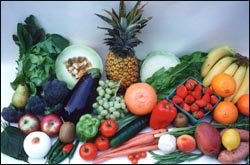
Photo 17. Eat plenty of vegetables and fruits. Copyright ⓒ 2011 John Sangwon Lee, M.D., FAAP

Photo 18. If you fit your constitution, consume enough milk or food made from milk. Copyright ⓒ 2011 John Sangwon Lee, M.D., FAAP
The following is an example of Internet pediatric health counseling Q&A regarding “cavities (caries), bleeding gums”.
Q&A.
Tooth decay (caries), bleeding gums
Q.
After passing the stone, caries from the milk bottle started and progressed slowly, but now all 4 front teeth are decaying. When I went to the dentist, they told me to come after two years, so I haven’t started treatment yet. I’m posting here wondering if there is any special management method before then. please reply thank you
A. to my brother Good morning. Thanks for asking.
That’s a good question. The more information you know, such as the child’s age, gender, past medical history, family history, examination findings, and clinical examination, it will help you to give an answer. We will give you an answer based on the information you provided. It appears that the baby has tooth decay (caries).
Tooth decay can be caused by: Nutrients are taken during pregnancy, nutritional status after birth, fluoride intake, the habit of biting a bottle of milk to sleep, and eating a lot of sugary sweets or candy can make tooth decay more easily. It is especially easy to develop tooth decay if you suck on the bottle, put the bottle to sleep, or feed from a bottle with juice at any time. I’m not sure what causes the gums to bleed. Please get a diagnosis from a pediatric adolescent and consult about these issues.
And get a referral from the pediatrician and get treatment at the dentist. Let’s see if there are any problems with your baby’s diet. See also caries. If you have more questions, please contact us again. Thank you. Lee Sang-won.
출처 및 참조 문헌 Sources and references
- NelsonTextbook of Pediatrics 22ND Ed
- The Harriet Lane Handbook 22ND Ed
- Growth and development of the children
- Red Book 32nd Ed 2021-2024
- Neonatal Resuscitation, American Academy of Pediatrics
- Screening and interventions to prevent Dental Caries in Young Children, JAMA, 12/7/2021
-
Oral Health The Pediatric Clinics of North America, Stuart D.Josell
-
Pediatric Oral Health Stuart Jose
-
Ann L. Griffen, DDS, MS
-
Atlas Pediatric Physical Diagnosis Frank A Oski
- www.drleepediatrics.com 제1권 소아청소년 응급 의료
- www.drleepediatrics.com 제2권 소아청소년 예방
- www.drleepediatrics.com 제3권 소아청소년 성장 발육 육아
- www.drleepediatrics.com 제4권 모유,모유수유, 이유
- www.drleepediatrics.com 제5권 인공영양, 우유, 이유식, 비타민, 미네랄, 단백질, 탄수화물, 지방
- www.drleepediatrics.com 제6권 신생아 성장 발육 육아 질병
- www.drleepediatrics.com제7권 소아청소년 감염병
- www.drleepediatrics.com제8권 소아청소년 호흡기 질환
- www.drleepediatrics.com제9권 소아청소년 소화기 질환
- www.drleepediatrics.com제10권. 소아청소년 신장 비뇨 생식기 질환
- www.drleepediatrics.com제11권. 소아청소년 심장 혈관계 질환
- www.drleepediatrics.com제12권. 소아청소년 신경 정신 질환, 행동 수면 문제
- www.drleepediatrics.com제13권. 소아청소년 혈액, 림프, 종양 질환
- www.drleepediatrics.com제14권. 소아청소년 내분비, 유전, 염색체, 대사, 희귀병
- www.drleepediatrics.com제15권. 소아청소년 알레르기, 자가 면역질환
- www.drleepediatrics.com제16권. 소아청소년 정형외과 질환
- www.drleepediatrics.com제17권. 소아청소년 피부 질환
- www.drleepediatrics.com제18권. 소아청소년 이비인후(귀 코 인두 후두) 질환
- www.drleepediatrics.com제19권. 소아청소년 안과 (눈)질환
- www.drleepediatrics.com 제20권 소아청소년 이 (치아)질환
- www.drleepediatrics.com 제21권 소아청소년 가정 학교 간호
- www.drleepediatrics.com 제22권 아들 딸 이렇게 사랑해 키우세요
- www.drleepediatrics.com 제23권 사춘기 아이들의 성장 발육 질병
- www.drleepediatrics.com 제24권 소아청소년 성교육
- www.drleepediatrics.com 제25권 임신, 분만, 출산, 신생아 돌보기
- Red book 29th-31st edition 2021
- Nelson Text Book of Pediatrics 19th- 21st Edition
- The Johns Hopkins Hospital, The Harriet Lane Handbook, 22nd edition
- 응급환자관리 정담미디어
- Pediatric Nutritional Handbook American Academy of Pediatrics
- 소아가정간호백과–부모도 반의사가 되어야 한다, 이상원 저
- The pregnancy Bible. By Joan stone, MD. Keith Eddleman, MD
- Neonatology Jeffrey J. Pomerance, C. Joan Richardson
- Preparation for Birth. Beverly Savage and Dianna Smith
- 임신에서 신생아 돌보기까지. 이상원
- Breastfeeding. by Ruth Lawrence and Robert Lawrence
- Sources and references on Growth, Development, Cares, and Diseases of Newborn Infants
- Emergency Medical Service for Children, By Ross Lab. May 1989. p.10
- Emergency care, Harvey Grant and Robert Murray
- Emergency Care Transportation of Sick and Injured American Academy of Orthopaedic Surgeons
- Emergency Pediatrics A Guide to Ambulatory Care, Roger M. Barkin, Peter Rosen
- Quick Reference To Pediatric Emergencies, Delmer J. Pascoe, M.D., Moses Grossman, M.D. with 26 contributors
- Neonatal resuscitation Ameican academy of pediatrics
- Pediatric Nutritional Handbook American Academy of Pediatrics
- Pediatric Resuscitation Pediatric Clinics of North America, Stephen M. Schexnayder, M.D.
-
Pediatric Critical Care, Pediatric Clinics of North America, James P. Orlowski, M.D.
-
Preparation for Birth. Beverly Savage and Dianna Smith
-
Infectious disease of children, Saul Krugman, Samuel L Katz, Ann A.
-
Emergency Care Transportation of Sick and Injured American Academy of Orthopaedic Surgeons
-
Emergency Pediatrics A Guide to Ambulatory Care, Roger M. Barkin, Peter Rosen
-
Gray’s Anatomy
-
제19권 소아청소년 안과 질환 참조문헌 및 출처
- Habilitation of The handicapped Child, The Pediatric Clinics of North America, Robert H Haslam, MD.,
-
Pediatric Ophthalmology, The Pediatric Clinics of North America, Leonard B. Nelson, M.D.
-
Pediatric Ophthalmology, The Pediatric Clinics of North America, Lois J. Martyn, M.D.
-
Pediatric Ophthalmology, Edited by Robison D. Harley, M.D.
-
The Pediatric Clinics of North America, David Tunkel, MD., Kenneth MD Grundfast, MD
|
Copyright ⓒ 2015 John Sangwon Lee, MD., FAAP 미국 소아과 전문의, 한국 소아청소년과 전문의 이상원 저 “부모도 반의사가 되어야 한다”-내용은 여러분들의 의사로부터 얻은 정보와 진료를 대신할 수 없습니다. The information contained in this publication should not be used as a substitute for the medical care and advice of your doctor. There may be variations in treatment that your doctor may recommend based on individual facts and circumstances. “Parental education is the best medicine.” |